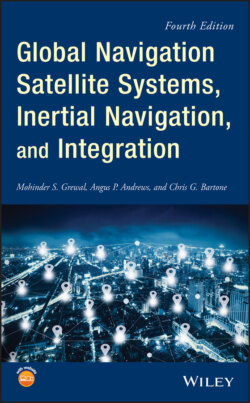Читать книгу Global Navigation Satellite Systems, Inertial Navigation, and Integration - Mohinder S. Grewal - Страница 17
1.1.2 Navigation Modes
ОглавлениеFrom time immemorial, we have had to solve the problem of getting from A to B, and many solution methods have evolved. Solutions are commonly grouped into five basic navigation modes, listed here in their approximate chronological order of discovery:
Pilotage essentially relies on recognizing your surroundings to know where you are (A) and how you are oriented relative to where you want to be (B). It is older than human kind.
Celestial navigation uses relevant angles between local vertical and celestial objects (e.g. the Sun, planets, moons, stars) with known directions to estimate orientation, and possibly location on the surface of the Earth. Some birds have been using celestial navigation in some form for millions of years. Because the Earth and these celestial objects are moving with respect to one another, accurate celestial navigation requires some method for estimating time. By the early eighteenth century, it was recognized that estimating longitude with comparable accuracy to that of latitude (around half a degree at that time) would require clocks accurate to a few minutes over long sea voyages. The requisite clock technology was not developed until the middle of the eighteenth century, by John Harrison (1693–1776). The development of atomic clocks in the twentieth century would also play a major role in the development of satellite‐based navigation.
Dead reckoning relies on knowing where you started from, plus some form of heading information and some estimate of speed and elapsed time to determine the distance traveled. Heading may be determined from celestial observations or by using a magnetic compass. Dead reckoning is generally implemented by plotting lines connecting successive locations on a chart, a practice at least as old as the works of Claudius Ptolemy (∼85–168 CE).
Radio navigation relies on radio‐frequency sources with known locations, suitable receiver technologies, signal structure at the transmitter, and signal availability at the receiver. Radio navigation technology using land‐fixed transmitters has been evolving for about a century. Radio navigation technologies using satellites began soon after the first artificial satellite was launched.
Inertial navigation is much like an automated form of dead reckoning. It relies on knowing your initial position, velocity, and attitude, and thereafter measuring and integrating your accelerations and attitude rates to maintain an estimate of velocity, position, and attitude. Because it is self‐contained and does not rely on external sources, it has the potential for secure and stealthy navigation in military applications. However, the sensor accuracy requirements for these applications can be extremely demanding [2]. Adequate sensor technologies were not developed until the middle of the twentieth century, and early systems tended to be rather expensive.
These modes of navigation can be used in combination, as well. The subject of this book is a combination of the last two modes of navigation: global navigation satellite system (GNSS) as a form of radio navigation combined with inertial navigation. The key integration technology is Kalman filtering, which also played a major role in the development of both navigation modes.
The pace of technological innovation in navigation has been accelerating for decades. Over the last few decades, navigation accuracies improved dramatically and user costs have fallen by orders of magnitude. As a consequence, the number of marketable applications has been growing phenomenally. From the standpoint of navigation technology, we are living in interesting times.
